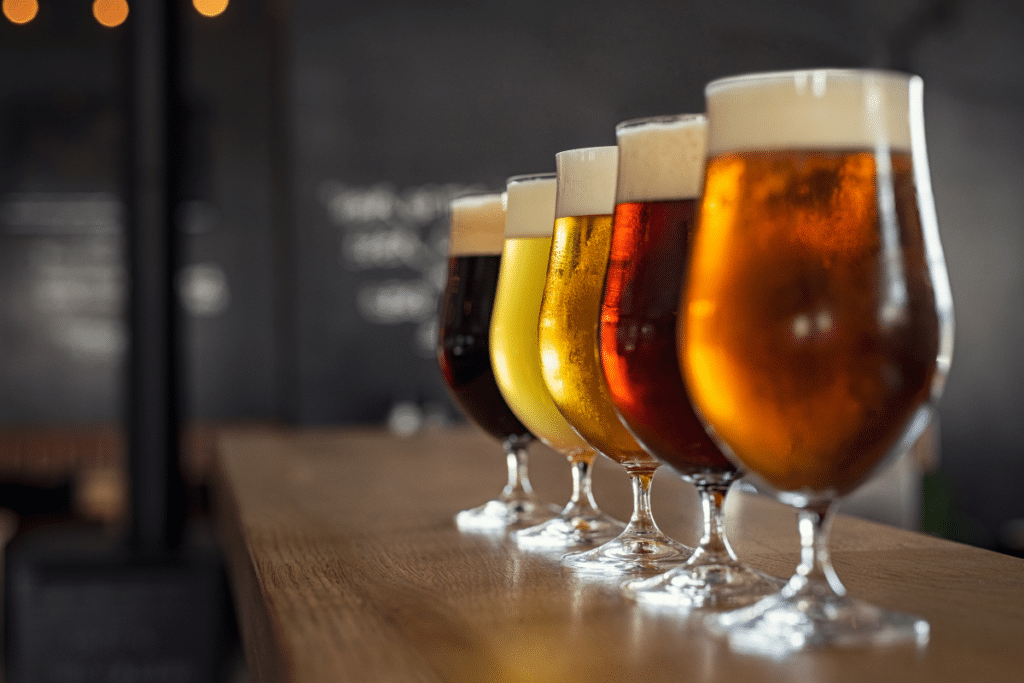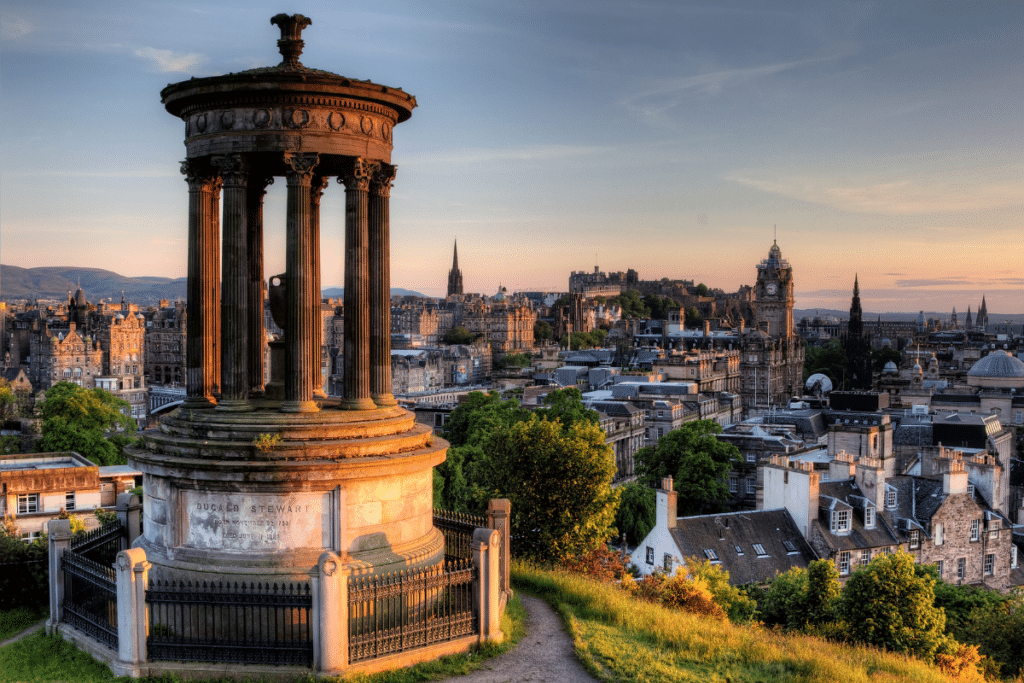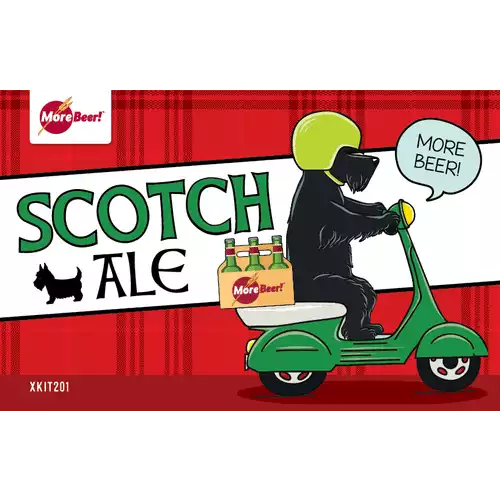If you love malty, sweet beers, pick up a Scotch Ale. This is a strong, malty beer with the perfect balance of sweetness, but what if you want to try to brew this ale at home?
Brew a full-bodied Scotch Ale – or Wee Heavy – with slightly hard water that has more chloride than sulfate. Start with a basic grain such as a British Pale Malt. Use specialty grains such as roasted, crystal, chocolate, and black malts. Use British hops in light quantities. Ferment using a clean yeast that has a low attenuation rate.
Keep reading to learn everything you need to know about the ingredients and process for brewing a Scotch Ale, plus what you should expect in your final product!
Topics We Cover
What is a Scotch Ale?
The Scotch Ale, also known as a Wee Heavy, is primarily characterized by its malt sweetness and depth of flavor. There isn’t much bitterness to speak of so brewers must make sure they don’t make it too sweet.
A Scotch Ale is a medium to dark ale with strong toffee and caramel flavors. This style is generally sweet with little bitterness and moderate to high alcohol content. Many have a light ester presence though it should not be overwhelming.

Defining characteristics of Scotch Ales include:
- Color – 14 – 25 SRM
- Common flavors – Caramel, toffee, bready malts
- Aroma – Bready malts, toasty malts, caramel
- Mouthfeel – Medium to full, average carbonation
- IBUs (Bitterness) – 17 – 35
- ABV – 6.5 – 10%
Like most ales, this style is flavorful and fairly high in alcohol by volume (ABV). The Scotch Ale is similar in some ways to an English Barley Wine. The difference is that Scotch Ales are usually darker.
History of the Scotch Ale
As you might expect, Scotch Ales are originally from Scotland. The first Scotch Ales were brewed in Edinburgh in the early 19th century. They were a natural continuation of malt-heavy beers in the area.
Prior to Scotch Ales were English Barley Wines. These malt-focused barley wines inspired Scottish brewers to lean into malts over hops. Another major influence was the fact that hops didn’t grow well in Scotland and were expensive to import.
The Scots, however, took it one step further by using caramelized sugar. This deepened the malt character and increased the caramel notes.
Popular commercial Scotch Ales
For the beer enthusiasts and the beer curious here’s a quick list of Scotch Ales you should try.

- McEwan’s Scotch Ale – Another 8% ABV ale, McEwan’s Scotch Ale is both smooth and warming. It boasts notes of brown sugar, mild coffee, and caramel.
- Founders Brewing Co. Dirty Bastard – This Scotch Ale brings notes of smoke and peat to the complexity of malt. Founders Brewing even adds in some notes of hop bitterness.
- Belhaven Brewery Wee Heavy – This Wee Heavy sits slightly lighter than the above while still clocking in at a respectable 7.4% ABV. This brew brings light biscuit sweetness and caramel to warming alcohol.
- Oskar Blues Brewery Old Chub – At 8% ABV, this is on the stronger end of Scotch Ales. Old Chub is full of strong malt flavors with notes of coffee, cocoa, and smoke.
Popular Scotch Ale recipe kits (all-grain or extract)
This Scotch Ale recipe is a huge, malty beer with a deep rich copper color. Scotch Ales have a flavor a little reminiscent of single malt Scotch with smoky overtones and roasted flavors.
How to brew a Scotch Ale
Once you’ve explored some great examples of Scotch Ale, you may be thinking of how to brew your own. In order to brew the best beer you need to know the style forward and backward. To that end, I will break down everything you need to know.
Brewing a proper Scotch Ale requires slightly hard water similar to what would have been traditionally found in Edinburgh. Start with a basic grain such as a British Pale Malt, then add specialty grains including roasted, crystal, chocolate, and black malts. Stick with British hops, but use them sparingly. Ferment using a low-attenuating yeast with low ester production.
Let’s start by going over some great choices for the recipe and ingredients. Then, we can look at the process including brew day, fermentation, and bottling.
Wondering how long you should set aside for your brew day? I’ve got the answer, plus a couple of great tips to keep things moving!
Recipe and ingredients
While you can’t have beer without fermentation, you can’t get anywhere without quality ingredients. There are of course no wrong ingredients, but some will go together much better than others.
The recipes for this style typically use the same ingredients with some variation here and there:
- Water profile
- Base grains
- Specialty grains or other additions
- Hops
- Yeast
As always, start with your water. Then consider your grain bill, hops, and finally yeast. Each one can have a significant impact on your final product.
Water profile
In general, good-tasting water produces good-tasting beer. However, a targeted water profile suited to your beer style can make all the difference.
The best water profile for a Scotch Ale is slightly hard with a lean towards chlorides over sulfates.

Don’t use water that is too hard, but low to moderately hard water will accentuate a darker Scotch Ale. You’ll generally want lower sulfates. The chlorides will enhance the malt flavors that will be in the spotlight.
Some brewers prefer a sulfate-leaning Scotch Ale as the sulfates will help dry out the beer and enhance any hop bitterness. This is slightly outside of the style, but if you prefer a dryer beer this may be a way to reduce the sweetness while keeping the malt complexity.
Lastly, use a brewing calculator once you’ve determined your grain bill. If you use a lot of dark malts, you may need to adjust for their acidity in the mash. You want your mash pH between 5.2 and 5.6.
If you like the Scotch Ale, you may want to try brewing another beer from the British Isles – the Foreign Extra Stout!
Base grains
High-quality base grains make a big difference in a beer, even if they’re not the star of the show.
In a Scotch Ale, use a pale malt for a basic flavor canvas. An English Pale Malt such as Maris Otter is a great choice.
Your base grains don’t have to be all that complex. Choose your favorite pale malt and move on to specialty grains for the fun stuff.
Specialty grains or other additions
Specialty grains build on the base grain to provide the body and most of the really memorable parts of a beer.
The best specialty grains for a Scotch Ale are crystal malt and roasted barley. Additionally, black malt and chocolate malts are great choices.
These specialty grains should be used in much smaller quantities. This is especially true of darker malts such as black malts. The quantity and variety you use are entirely dependent on the color and flavors you’re aiming for.
The crystal malts will add some complex sugars that will contribute to the body. These malts also add caramel flavor which is highly desired for the style.
Roasted barley will add coffee notes along with a dryer profile. This malt is great for adding a more stout-like character.
Black malts will be a strong addition so don’t use too much–certainly not much more than 5% of the grain bill. These malts will be slightly less dry than roasted barley.
Finally, chocolate malts will add a chocolate flavor and hints of coffee. Like black malts don’t use too much.
Hops
A Scotch Ale does not call for a lot of hop characteristics.
Keep the bitterness low and the hop aromas subtle. Use light additions of British hops.
While you could use American hops varieties, most are not typical for the style and would likely clash with the beer. Some of the less bold American hops would be possibilities.
Often brewers will use hop varieties with high alpha acid concentrations to reduce trub. In this beer, these varieties could add too much bitterness. It is generally better to use lower AA varieties.
Bittering
Bittering hops added early in the boil will go through a process called isomerization. This is what gives a beer its bitterness.
A Scotch Ale calls for anywhere from 17 to 35 IBUs. Use small amounts of bittering hops if desired.
Here are some good choices for bittering hops.
| Name | Purpose | Alpha Acid % |
|---|---|---|
| Challenger | Bittering + Aroma | 6.5-9% |
| East Kent Goldings | Aroma | 4.5-6.5% |
| Admiral | Bittering | 13-16% |
| Cascade | Bittering + Aroma | 4.5-7% |
Aroma and Flavor
Aroma and flavor hops added towards the end of the boil don’t add much bitterness. Instead, they add oils that provide flavor and aroma.
These hops should be used sparingly when brewing a Scotch Ale, but can help balance the beer when used correctly.
Here are a few good choices to get you started.
| Name | Flavor/aroma | Alpha Acid % |
|---|---|---|
| East Kent Goldings | Woody, citrus, spicy, vegetal | 4.5-6.5% |
| Northern Brewer | Woody, minty | 9.5% |
| Willamette | Floral, fruity, spicy | 4-6% |
| Fuggles | Vegetal, woody, floral | 3.5-6% |
Yeast
And, of course, you can’t have beer without yeast!
A Scotch Ale calls for a yeast strain that has low to medium attenuation, high flocculation, and low ester production.
Generally, a cleaner yeast is best, but some ester production is allowed in this style. The level of attenuation can also be managed in the mash if you want to use a higher attenuating yeast.
Dry
Below are some good dry yeast options for a Scotch Ale.
| Name | Attenuation | Flocculation | Temperature Range |
|---|---|---|---|
| Safale US-05 | 78-82% | Medium | 64.4-78.8°F |
| Safale S-04 | 74-82% | High | 64.4-78.8°F |
| Nottingham | 77% | High | 50-72°F |
Liquid
Below are some good liquid yeast options for a Scotch Ale.
| Name | Attenuation | Flocculation | Temperature Range |
|---|---|---|---|
| Wyeast 1728 | 69-73% | High | 55-70°F |
| WLP028 | 70-75% | Medium | 65-70°F |
| WLP011 | 65-70% | Medium | 65-70°F |
Brewing process
After acquiring all of your ingredients you can move on to brew day. What you do on brew day can have just as much impact on your results as your choices of ingredients. On brew day, one of the most important aspects is sanitization. Be thorough when sanitizing!
All-grain, partial, and extract brewing each have important considerations for you to make. When doing all-grain or partial brewing you need to consider mashing and sparging. From there the other considerations are similar. The boil step and on is the same for all three.
Let’s break down each step with the Scotch Ale in mind.
Mashing
For a Scotch Ale, your mash temperature should be between 154°F and 156°F. This range will keep the beer from getting too sweet while leaving some complex sugars for the body.
While this is a sweeter beer, you don’t want it to get too sweet. Mashing at higher temps will result in more unfermentable sugars which can make the sweetness skyrocket. Shoot for the lower end especially when you use a lot of caramel malts.
Boil
The boil is necessary to sterilize the wort, denature enzymes activated during the mash stage, and stabilize the proteins.
The boil for a Scotch Ale should be at least an hour long. Boiling for an hour and a half to two hours can help add caramel flavors. You won’t have many hop additions and most will likely be in the last half hour.
The hop addition times depend heavily on the amount, alpha acid concentration, and purpose. Since this style calls for little hop character the additions will balance bittering and aroma.
In the case of this style, boiling for longer can start kettle caramelization. This adds to the malt flavors and overall character of the beer. However, this same reaction can create diacetyl. Too much is undesirable.
Whirlpool or flameout
Boil aside, there are other times to add hops. They aren’t strictly necessary but can be great for adding flavor and aroma. You won’t need to do any flameout hop additions in this style.
Adding hops during flameout can be a great way to get the flavors and almost no bitterness. This is done directly after the boil and before you pitch yeast. As you transfer to your fermentor create a whirlpool as you drain the boiling vessel.
This is only possible when you have a vessel that can drain from the bottom. Whirlpooling can also be a great way to collect the trub in the middle and reduce the amount that gets in your fermentor.
Fermentation
As always, fermentation is crucial but mostly hands-off.
When fermenting a Scotch Ale, keep the temperatures low. This will prolong the process but will result in a great beer. Include one temperature rise towards the end of the second week to ensure the fermentation finishes.
Keeping the fermentation at a consistent temperature will help keep your brew clean from any fermentation byproducts. Temperature steps can help control what the yeast is doing. Since this beer ferments at a lower temperature, raising it can provide one last kick to finish.
Temperatures
The temperature you ferment at will depend on the strain of yeast you use.
While the temperatures are yeast dependent there is a rough range you should keep your Scotch Ale near. Try to keep your fermentor around 55°F to 65°F for the majority of the process.
If you miss your temp goals by a few degrees or can’t keep it consistent it won’t be the end of the world. This level of micromanaging is great for elevating your final product but isn’t essential.
Bottling or kegging
The debate between bottling and kegging will go on for as long as brewers have a choice. It is truly up to personal preference and setup.
There is little preference between bottling and kegging for Scotch Ales. Kegging will allow you to bulk condition while bottles can make it easier to save portions for aging.
Choose the method that is easiest for you.
Scotch Ale recipes
If you aren’t one to create your own recipes here are a few that you can follow for great results. These recipes are from various brewers as credited below.
- Caroline’s Scotch Ale (All Grain)
- Wee Heavy (All Grain)
- Extract Scotch Ale (Extract)
Caroline’s Scotch Ale (All Grain)
This recipe comes from user Herr Braumeister on Brewer’s Friend.
Ingredients
- UK Golden Promise – 16 lb
- US Caramel 80° L – 1 lb
- Smoked malt – 0.25 lb
- US Dark Chocolate – 0.25 lb
- US Roasted Barley – 2 oz
- Northern Brewer hops – 1 oz
- Willamette hops – 0.5 oz
- WLP028
- Whirlfloc
Method
- Heat 6.5 gallons to 154°F.
- Add grain bill and mash for 1 hour.
- Mashout.
- Collect 6.5 gallons of wort.
- Boil for 90 minutes.
- At 60 minutes left add the Northern Brewer.
- At 15 minutes left add the Willamette.
- Flameout and add the Whirlfloc. Then transfer to the fermentor.
- Cool and pitch yeast.
- Maintain 60°F during fermentation.
- Rack to keg or bottles after about 2 weeks in primary. Enjoy!
Wee Heavy (All Grain)
This recipe comes from user Brewer #63258 on Brewer’s Friend.
Ingredients
- Canadian Pale 2-row – 8 lb
- German Vienna – 24 oz
- UK Brown malt – 9 oz
- UK Amber malt – 9 oz
- German Smoked malt – 2 oz
- Canadian Pale Wheat – 2 lb
- UK Crystal 70°L – 1 lb
- UK Crystal 45°L – 1 lb
- German Carapils – 1 lb
- Flaked Oats – 35 oz
- Saaz hops – 3 oz
- East Kent Goldings hops – 1 oz
- WLP840
Method
- Heat 6 gallons to 154°F.
- Add grain bill and mash for 1 hour.
- Mashout.
- Collect 5.89 gallons of wort.
- Boil for 75 minutes.
- At 30 minutes left add the Saaz.
- Flameout and add the East Kent Goldings. Then transfer to the fermenter.
- Cool and pitch yeast.
- Maintain 55°F during fermentation.
- After fermentation, rack to keg or bottles. Enjoy!
Extract Scotch Ale (Extract)
This recipe comes from user Genus Brewing on Brewer’s Friend.
Ingredients
- DME Light – 10 lb
- US Caramel 75° L – 0.75 lb
- Belgian Aromatic – 0.75 lb
- German Smoked Malt – 0.5 lb
- Chinook hops – 2 oz
- Wyeast 1084
Method
- Heat 3 gallons of water for your boil.
- Add the steeping grains when the water is around 140°F.
- Steep for roughly 20 minutes.
- Remove the grains when the water is around 170°F.
- When a boil is reached, add 9 lb of the malt extract.
- Boil for 60 minutes. Add 1 oz of the Chinook right away.
- At 20 minutes left, add the rest of the Chinook and the DME.
- Flameout and transfer to the fermentor.
- Cool and pitch yeast.
- Maintain 60°F during fermentation.
- After a week or so in primary, rack to keg and force carbonate or bottle condition.
Did you know that we have a full library of homebrew beer recipes for every style?


